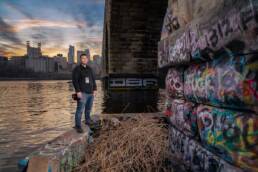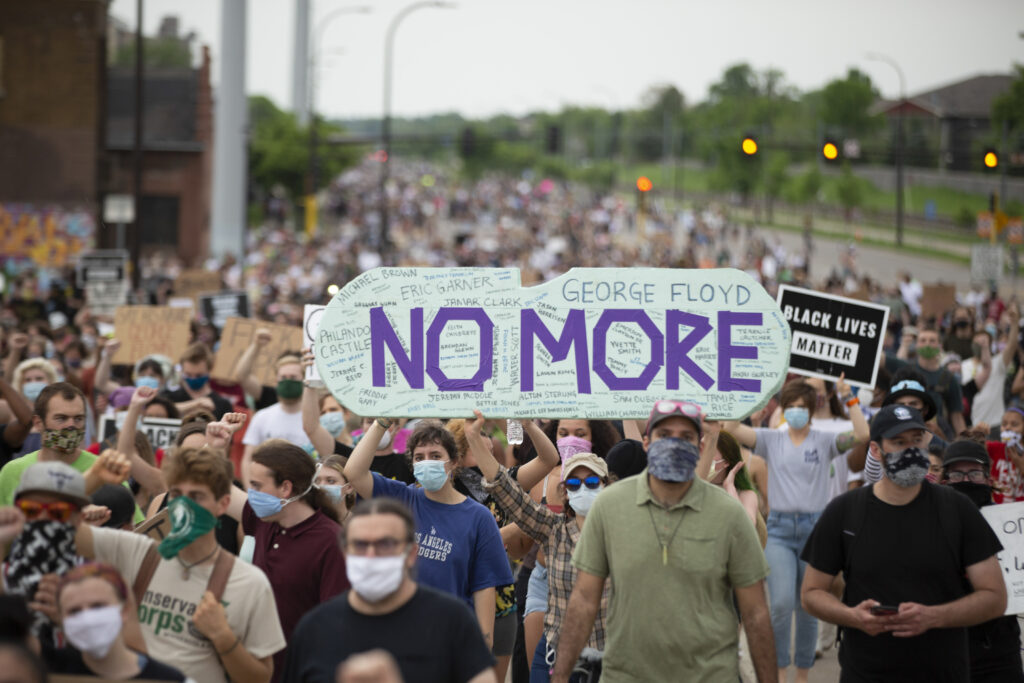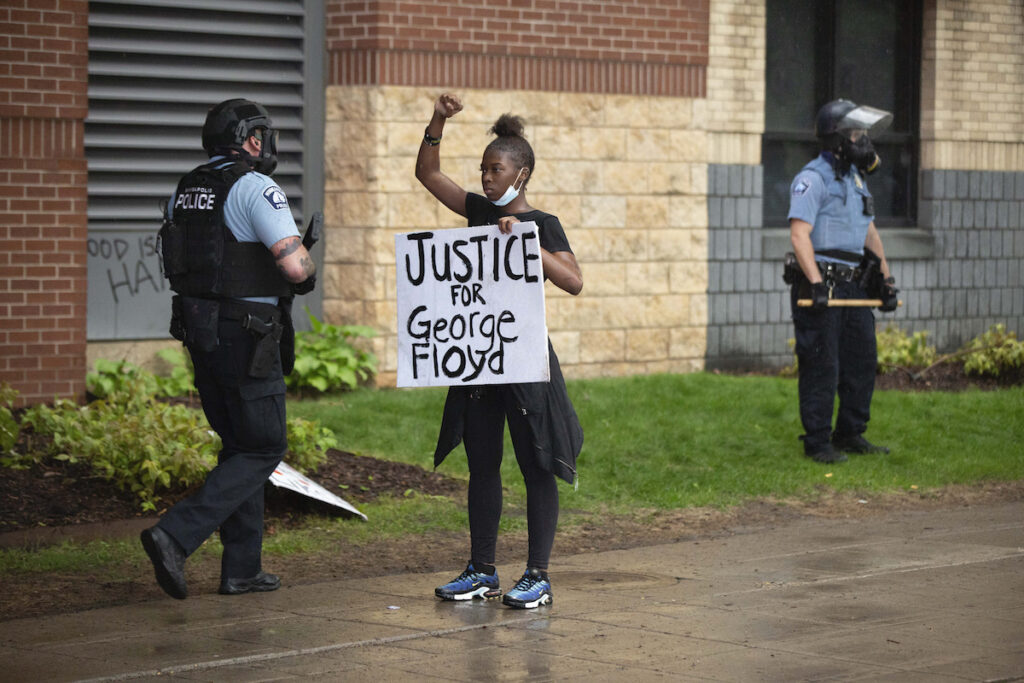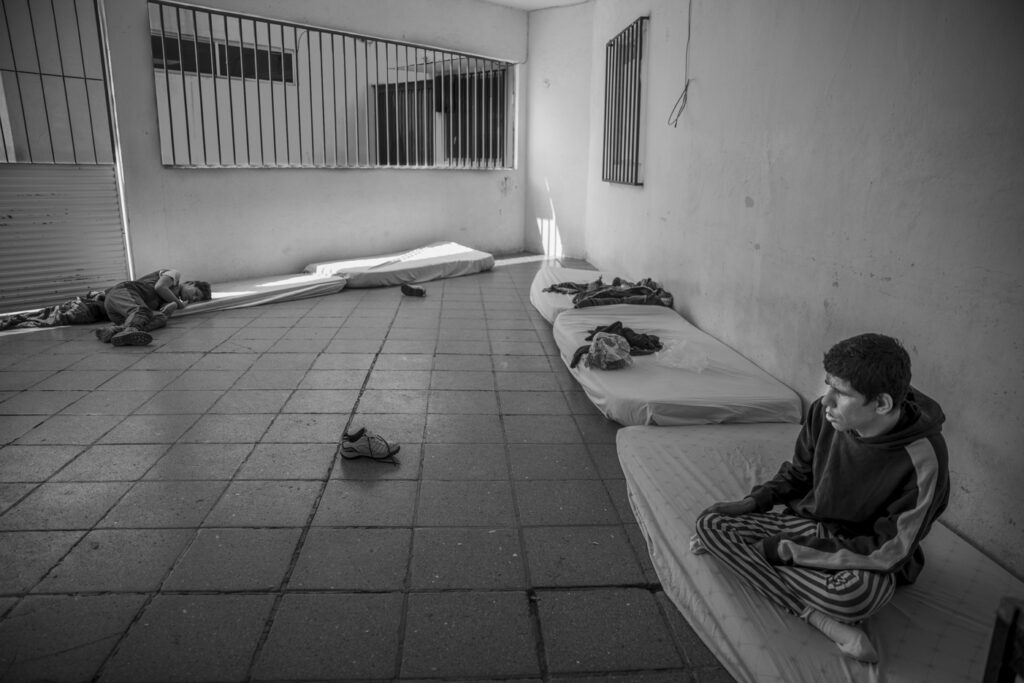Community support has kept me going, knowing that people appreciate the work I do. If it weren’t for them, I probably wouldn’t be doing this still. Sometimes, when I’ve been dealing with emotional trauma, they have propped me up. Seeing people appreciate my work makes me realize I’m having an impact. I don’t think people know how powerful that is for independent journalists.
— Chris Juhn

Childhood Bullying and Autism Diagnosis
I was bullied all of my childhood, which made school difficult. I tried to fit in, but I never could. I later realized that it was because of my autism.
I don’t remember a lot from my early years. I grew up in Burnsville, close enough to Echo Park Elementary that I walked to school. I was picked on a lot and some of the teachers harassed me. They didn’t understand why I was different. I had a speech impediment and during speech therapy the school realized there was more wrong than just my speech. After two years of doctor visits, I was diagnosed with ADHD which was the wrong diagnosis.
I remember the moment I was diagnosed with P.D.D., pervasive developmental disorder (now grouped under the term autism spectrum disorder). I was in the fifth grade. My parents came out of the doctor’s office, crying. After that doctors visit I transferred schools into one with a Special Education program specific to children with autism.
Special Education: Unintended Psychological Abuse
The first day I went to my new school I saw a kid get restrained. It became a regular thing, to the point where it just seemed normal. Back then I didn’t know this was wrong. Kids would throw chairs and the teachers would pile up on them. They didn’t know how to handle an autistic meltdown. Over time, it causes life-long trauma that may never leave the person. It also intensifies the discomfort.
Still, that school seemed like paradise compared to Echo Park. But I was only there half a year. Then I hit Middle School. It was ok at first. I was excited to be in regular classes, but then this teacher came down, smiling and overly happy and brought me up to the Special Ed classroom. From 5th through 8th grade, I did addition, subtraction, and check-booking for math. When I said I wanted to have something more challenging I was yelled at and told that the teacher knew best. As time went on I just kept my mouth shut and learned to accept I would never learn anything new in school. It was painful because I knew I was falling behind and probably would never catch up to students in “normal,” mainstream classes.
When you’re going through Special Ed it seems like the teachers don’t care to try to challenge you. After I graduated, I realize how limited and overworked they were. If you put six or seven kids together with radically different educational needs it’s hard for the teacher to help everybody. You are all sort of set up for failure from the beginning.
Special Olympics: A Saving Grace
The one thing that saved me in middle and high school was competing in adaptive sports and Special Olympics. It was my escape and where I felt human. It helped me get through those rough moments and it was good socialization for me. I was on the Dakota United Hawks which had kids from Burnsville, Eagan, Apple Valley, and Rosemount. I competed from 8th grade through high school. The last 3 years we won three state titles for adaptive floor hockey and I broke the state record with 44 goals in a single season.
I had more independence in high school and could take more “normal” classes, but at a certain point I stopped caring about my grades because even those normal classes were the easy ones for non-disabled students. What does it matter if I got an A or an F? My education was a joke. I graduated with a C average. When I asked about taking the SAT, they said I could but told me they “frowned on it.”
For me, Special Ed was full of unintended psychological abuse. Being on an adaptive team with kids from other special education programs I saw that my experience was not unusual. We were all taught the same bad curriculum. When your education is built around being separated from non-disabled, “normal” students, you see yourself as less of a person. When you tell someone they’re different their entire lives you lower that person’s expectations of themselves. I saw many people that had potential give up on their dreams before they even graduated high school.
Transitions Plus
After high school, I went to a program called Transitions Plus until I was 21. They say they will help you be successful, but I felt they were mostly there to help you get on SSI and SSDI and into some sort of assisted living situation like a group home.
They did pay for technical or community college through a post-secondary Education Option, but it was hard to be successful because you rely on the program’s bus schedule and many of the students were in group homes or other living facilities which made it hard to take classes. Some of the students at Transition Plus went to college, but nobody really was all that successful. They helped you take classes, but it was almost like they expected you to fail.
Embracing my sexuality; starting to heal in rehab
I realized that I was gay in high school, but it was hard for me to accept it. Being “that special ed kid” in school, I didn’t want to add another label to myself.
When I attended Transition Plus I wanted to explore this part of me. I ended up finding a place called District 202 which was an LGBT youth center. At first, I wasn’t too sure about going there but eventually the people there became like an extended family. Whenever I wasn’t busy working or going to Transition Plus I was over there. For me accepting my sexuality was easy because my biggest struggle wasn’t that part of my identity.
One thing Special Ed and the public school system did was it left me with mental and emotional scars. I started to drink a lot. It became an everyday thing because it would drown out the pain I was experiencing and I liked how it made me feel. I ended up with a DUI and court-appointed rehab and went to an in-patient treatment center. I was angry I had to go there, but after being there for a few days, for the first time in a long time, I felt human again. I was with other people who had struggled in life and I felt connected to them even though our struggles in certain ways were different.
The in-patient treatment center and the 12 steps allowed me to start to assess my life and take a deep, honest look at myself. I began working out for the first time and to work on myself without outside distractions.
After I left treatment, I kept working out. Rehab ended up being the best thing possible for me at the time. I joined a martial arts gym that had boxing, jiu-jitsu, and Muay Thai, I lost over 80 pounds in six months and I started to gain confidence for the first time in my life. I realized that my problem wasn’t the alcohol; it was my past and not addressing it correctly. People I trained with at the gym started to be like a family. That was the start of a long healing process, but I still had a long way to go. At this point I was still attending Transition Plus.
Discovering Photography
While I was at Transitions Plus, I discovered photography. I got some Christmas money, bought a point and shoot camera, and I fell in love with photography. I started walking around Minneapolis with my camera. I’d get on the bus, go downtown, and walk around taking photos. It was an addiction for me.
College and Community Activism in Grand Rapids, MN
When I graduated from Transitions Plus, I talked to people who were photographers and they encouraged me to seek a business degree. I started dating someone for about a year or so. It got to the point where we decided to take it to the next level and he convinced me to take classes with him at Itasca Community College in Grand Rapids, MN. I got accepted into that college and was registered for classes. I found lodging, but he dumped me right before I moved up. It seemed like the end of the world. In reality it was the start of something better. I was crushed but stubborn. I went to Itasca Community College anyway.
Starting classes I felt alone and I didn’t know what I was going to do. For my entire life, I had someone there holding my hand and guiding me. This was my first time on my own. But after a few months I learned that I liked it and that those holding my hand were really holding me back.
I didn’t want to sit and do nothing besides classes so I joined the Student Senate. That eventually led to me volunteering at the Grand Rapids DFL office, and becoming the Media Director for someone’s political campaign. I raised thousands of dollars for the school’s literary magazine. It was the time of Occupy, and I co-founded Occupy MN in Grand Rapids. I also took photographs and wrote for the local paper as a volunteer. I did all this, in a way, to prove I could. I got really good at making things happen.
However, doing all that took away from my studies and I failed my classes. I decided to follow my passion and enroll in photography classes. Itasca Community College put me on academic suspension and I had to wait a semester to start back up again, so I returned to the Twin Cities to pursue a photography degree at Hennepin Technical College.
Partners in Policy Making
In Grand Rapids, Minnesota, I learned about an advocacy training program called the Partners in Policy Making, which was through the Minnesota Governor’s Council on Disability. It was a 150-hour training program to teach you how to be a better advocate. It taught me about the political process and how to advocate for disability rights. They would bring in Representatives, and lobbyists—people who were passionate and knowledgeable with the goal of creating advocates for disability rights. They’d talk for 8-10 hours over a weekend, in-depth. It was the best political training I have ever had.
Documenting Occupy Homes Minnesota
The first movement I documented was Occupy Homes, MN. I heard about it when Brother Ali was at the State Fair and he talked about it on the radio. I learned a lot following that movement. I saw that when it ended many of those activists stayed involved, moving on to other causes. Some began working for unions, others got involved with Black Lives Matter. I noticed that while organizations come and go, many people move to new causes, and activism evolves through that.
Documenting Protest of Police Murders: Jamar Clark, Philando Castile, Justine Damond
The next major movement I followed was the Minneapolis 4th Police Precinct occupation after the murder of Jamar Clark by the Minneapolis Police. It lasted 18 days, and there were actions to document until the case went to court.
At the 4th precinct, I found that I could capture emotion the way I never had before. I became known by activists for being there every day. During my coverage of the protests I ended up getting a contract to shoot for MPR News. Regina McCombs hired me as a freelancer. She, in many ways, mentored me and taught me a lot. That was the first news outlet beyond the Spokesman-Recorder that hired me to do work.
Just after Mark Ringgenberg and Dustin Schwarze—the officers who killed Jamar Clark—had their charges dropped, Officer Yanez killed Philando Castile. I photographed the BCA examining Philando’s car. No one planned the occupation of Governor’s Mansion. People went there to demand justice and they decided to stay until they got answers. It became the Governor’s Mansion occupation. It was kind of organic in the way it happened.
After Philando Castile’s case ended and Yanez was let off on charges, Justine Damond was killed. That case got international attention because she was Australian. There were many other police shootings. I feel bad not mentioning others, but those were the biggest actions I covered up until 2020.

2020
When the pandemic hit, everything I was photographing got canceled. I took pictures of empty streets and essential workers in grocery stores. I tried to get into a hospital, but that was impossible because of HIPAA laws. After George Floyd’s murder, however, there was more happening than I could get to, more than I, or probably anyone else, had experienced.
Like Philando Castile, George Floyd’s murder was filmed. The reaction, however, was different. What I thought would just be protests turned into a riot. Everyone was caught off guard. I found so many stories, so many layers to what was going on. The demonstrations around George Floyd spread across the country and, eventually, the world. For a moment in time, the world stood with Minneapolis.
While documenting the protests, I was shot at, hit with tear gas and stun grenades. I heard what sounded like shootouts in the distance. I was in a drive-by. Being in the middle of it with my camera became mentally and emotionally exhausting.

Able Press
Starting to work as a journalist, I realized there was a demographic missing in newsrooms. According to the U.S. Census Bureau, 20% of the United States population has a disability of some kind. Yet, we don’t have a lot of folks in newsrooms who are openly disabled. As the Black community and other minority communities have found out, representation matters.

I realized last year that we need a disability-specific news organization. There are a few, but none function as a daily newspaper. I came up with the idea for ABLE Press.
My mission statement:
ABLE Press is a disability-focused news outlet created by and for people with disabilities. Our mission is to create compelling journalism that shows the reality of our communities, informs us about issues affecting us, and creates a conversation around these issues. Through covering our own communities, we will create a space where disabled voices are heard and amplified.
We Strive To
– Create local, compelling, disability-focused journalism
– Be accessible to as many people in the disability community as possible
– Challenge stigmas around disability through quality journalism
– Present a model for showcasing the wealth and resources available in the disability community
Core Audiences
Our core audience is people living with disabilities in Minnesota. We want to resonate with every age group and ability. The secondary audience is those around them (i.e., family members, loved ones, and caregivers).
Why ABLE
In most newsrooms across the country, there aren’t many openly disabled reporters. With the numerous articles published around disability, rarely is the reporter for those articles someone with a disability. This creates a disconnect with readers and shifts power away from our communities, creating the impression that we aren’t capable of telling our stories.
Breaking Down Barriers
Beyond the lack of inclusiveness in newsrooms, there are also significant obstacles faced by those with disabilities to achieve the academic credentials to enter the field of journalism. It puts the community at an extreme disadvantage in terms of fair and unbiased representation.
This creates a challenge because people with disabilities can’t get the training they need to work for a news organization, making it difficult to be considered for freelance work. This guarantees a large percentage of the disability population will never have a position in newsrooms, furthering the lack of the many disabled voices from being heard.
A Different Approach
ABLE Press will look at the voice rather than the degree. We want writers of all perspectives and life experiences from autism, down syndrome, cerebral palsy, schizophrenia, mobility issues, rare diseases, etc., to create content about their communities. ABLE Press represents the biggest minority group in the country and will aim to change the way disability is viewed through quality journalism that challenges and breaks stereotypes.
My Personal Struggles and Loss This Year
When things were settling down from the intensity of summer protests, I got a call from my dad, who told me my mom’s cancer started to spread to her brain and that she was hospitalized. She was given weeks to months to live.
I wasn’t able to see her the first night in the hospital. The day after I got back from California I was able to see my mom. I’ve never seen her in so much pain. The doctor gave her two weeks to live. I planned to come back and see her again the following day. She lost her battle with cancer early the next morning. I was able to say goodbye the day before, but it was still tough. My dad held her hand as she passed.
Five weeks after my mom’s funeral, my dad ended up in the hospital with COVID 19. He was on a ventilator, and he was induced into a coma twice. In total, he spent about a month between hospitalization and physical rehab. He beat COVID, but as of this publication, he is still on oxygen. I moved back in with him to provide 24/7 care until he can get well enough to be on his own. He still needs help with occasional things.
Growing Support for Alternative Journalism
We are at a moment when people are losing trust in the mainstream media. There is a shift in power toward alternative media. For example, Unicorn Riot, which struggled to make five grand at the beginning of 2020, raised over a million dollars. There is a real opportunity right now to grow alternative media sources.
Community support has kept me going, knowing that people appreciate the work I do. If it weren’t for them, I probably wouldn’t be doing this still. Sometimes, when I’ve been dealing with emotional trauma, they have propped me up in ways that they will never know. Seeing people appreciate my work makes me realize I’m having an impact. I don’t think people know how powerful that is for independent journalists.

